Convolutional Coding pot
Bạn đang xem bản rút gọn của tài liệu. Xem và tải ngay bản đầy đủ của tài liệu tại đây (598.64 KB, 38 trang )
Convolutional Coding
Today, we are going to talk about:
Another class of linear codes, known as Convolutional
codes.
Structures of the encoder and different ways for
representing it.: state diagram and trellis representation
of the code.
What is a Maximum likelihood decoder?
How the decoding is performed for Convolutional codes
(the Viterbi algorithm) ?
Soft decisions vs. hard decisions
2
Convolutional codes
Convolutional codes offer an approach to error control
coding substantially different from that of block codes.
A convolutional encoder:
encodes the entire data stream, into a single codeword.
does not need to segment the data stream into blocks of fixed
size (
Convolutional codes are often forced to block structure by periodic
truncation
).
is a machine with memory.
This fundamental difference in approach imparts a different
nature to the design and evaluation of the code.
Block codes are based on algebraic/combinatorial
techniques.
Convolutional codes are based on construction techniques.
3
Convolutional codes-cont’d
A Convolutional code is specified by three parameters
or where
is the coding rate, determining the number of data
bits per coded bit.
In practice, typically k=1 is chosen and we assume that from
now on.
K is the constraint length of the encoder a where the encoder
has K-1 memory elements.
There is different definitions in literatures for constraint length.
),,( Kkn
),/( Knk
nkR
c
/=
4
Block diagram of the DCS
Information
source
Rate 1/n
Conv. encoder
Modulator
Information
sink
Rate 1/n
Conv. decoder
Demodulator
sequenceInput
21
, ), ,,(
i
mmm=m
bits) coded ( rdBranch wo
1
sequence Codeword
321
, ), ,,,(
n
nijiii
i
, ,u, ,uuU
UUUU
=
=
= G(m)U
, )
ˆ
, ,
ˆ
,
ˆ
(
ˆ
21 i
mmm=m
dBranch worper outputs
1
dBranch worfor
outputsr Demodulato
sequence received
321
, ), ,,,(
n
nijii
i
i
i
, ,z, ,zzZ
ZZZZ
=
=Z
C
h
a
n
n
e
l
5
A Rate ½ Convolutional encoder
Convolutional encoder (rate ½, K=3)
3 shift-registers where the first one takes the
incoming data bit and the rest, form the memory
of the encoder.
Input data bits Output coded bits
m
1
u
2
u
First coded bit
Second coded bit
21
,uu
(Branch word)
6
A Rate ½ Convolutional encoder
1 0 0
1
t
1
u
2
u
11
21
uu
0 1 0
2
t
1
u
2
u
01
21
uu
1 0 1
3
t
1
u
2
u
00
21
uu
0 1 0
4
t
1
u
2
u
01
21
uu
)101(=m
Time
Output OutputTime
Message sequence:
(Branch word) (Branch word)
7
A Rate ½ Convolutional encoder
Encoder)101(=m
)1110001011(=U
0 0 1
5
t
1
u
2
u
11
21
uu
0 0 0
6
t
1
u
2
u
00
21
uu
Time
Output
Time
Output
(Branch word) (Branch word)
8
Effective code rate
Initialize the memory before encoding the first bit (all-
zero)
Clear out the memory after encoding the last bit (all-
zero)
Hence, a tail of zero-bits is appended to data bits.
Effective code rate :
L is the number of data bits and k=1 and Rc=1/n is assumed:
data
Encoder
codewordtail
ceff
R
KLn
L
R <
−+
=
)1(
9
Encoder representation
Vector representation:
We define n binary vector with K elements (one
vector for each modulo-2 adder). The i:th element
in each vector, is “1” if the i:th stage in the shift
register is connected to the corresponding modulo-
2 adder, and “0” otherwise.
Example:
m
1
u
2
u
21
uu
)101(
)111(
2
1
=
=
g
g
10
Encoder representation – cont’d
Impulse response representaiton:
The response of encoder to a single “one” bit that
goes through it.
Example:
11001
01010
11100
111011 :sequenceOutput
001 :sequenceInput
21
uu
Branch word
Register
contents
1110001011
1110111
0000000
1110111
OutputInput m
Modulo-2 sum:
11
Encoder representation – cont’d
Polynomial representation:
We define n generator polynomials, one for each
modulo-2 adder. Each polynomial is of degree K-1 or
less and describes the connection of the shift
registers to the corresponding modulo-2 adder.
Example:
The output sequence is found as follows:
22)2(
2
)2(
1
)2(
02
22)1(
2
)1(
1
)1(
01
1 )(
1 )(
XXgXggX
XXXgXggX
+=++=
++=++=
g
g
)()( with interlaced )()()(
21
XXXXX gmgmU =
12
Encoder representation –cont’d
In more details:
1110001011
)1,1()0,1()0,0()0,1()1,1()(
.0.0.01)()(
.01)()(
1)1)(1()()(
1)1)(1()()(
432
432
2
432
1
422
2
4322
1
=
++++=
++++=
++++=
+=++=
+++=+++=
U
U
gm
gm
gm
gm
XXXXX
XXXXXX
XXXXXX
XXXXX
XXXXXXXX
13
State diagram
A finite-state machine only encounters a finite number
of states.
State of a machine: the smallest amount of
information that, together with a current input to the
machine, can predict the output of the machine.
In a Convolutional encoder, the state is represented
by the content of the memory.
Hence, there are states.
1
2
−K
14
State diagram – cont’d
A state diagram is a way to represent the encoder.
A state diagram contains all the states and all possible
transitions between them.
Only two transitions initiating from a state
Only two transitions ending up in a state
15
State diagram – cont’d
10 01
00
11
outputNext
state
inputCurrent
state
101
010
11
011
100
10
001
110
01
111
000
00
0
S
1
S
2
S
3
S
0
S
2
S
0
S
2
S
1
S
3
S
3
S
1
S
0
S
1
S
2
S
3
S
1/11
1/00
1/01
1/10
0/11
0/00
0/01
0/10
Input
Output
(Branch word)
16
Trellis – cont’d
Trellis diagram is an extension of the state
diagram that shows the passage of time.
Example of a section of trellis for the rate ½ code
Time
i
t
1+i
t
State
00
0
=S
01
1
=S
10
2
=S
11
3
=S
0/00
1/10
0/11
0/10
0/01
1/11
1/01
1/00
17
Trellis –cont’d
A trellis diagram for the example code
0/11
0/10
0/01
1/11
1/01
1/00
0/00
0/11
0/10
0/01
1/11
1/01
1/00
0/00
0/11
0/10
0/01
1/11
1/01
1/00
0/00
0/11
0/10
0/01
1/11
1/01
1/00
0/00
0/11
0/10
0/01
1/11
1/01
1/00
0/00
6
t
1
t
2
t
3
t
4
t
5
t
1 0 1 0 0
11 10 00 10 11
Input bits
Output bits
Tail bits
18
Trellis – cont’d
1/11
0/00
0/10
1/11
1/01
0/00
0/11
0/10
0/01
1/11
1/01
1/00
0/00
0/11
0/10
0/01
0/00
0/11
0/00
6
t
1
t
2
t
3
t
4
t
5
t
1 0 1 0 0
11 10 00 10 11
Input bits
Output bits
Tail bits
19
Block diagram of the DCS
Information
source
Rate 1/n
Conv. encoder
Modulator
Information
sink
Rate 1/n
Conv. decoder
Demodulator
sequenceInput
21
, ), ,,(
i
mmm=m
bits) coded ( rdBranch wo
1
sequence Codeword
321
, ), ,,,(
n
nijiii
i
, ,u, ,uuU
UUUU
=
=
= G(m)U
, )
ˆ
, ,
ˆ
,
ˆ
(
ˆ
21 i
mmm=m
dBranch worper outputs
1
dBranch worfor
outputsr Demodulato
sequence received
321
, ), ,,,(
n
nijii
i
i
i
, ,z, ,zzZ
ZZZZ
=
=Z
C
h
a
n
n
e
l
20
Optimum decoding
If the input sequence messages are equally likely,
the optimum decoder which minimizes the probability
of error is the Maximum likelihood decoder.
ML decoder, selects a codeword among all the
possible codewords which maximizes the likelihood
function where is the received
sequence and is one of the possible codewords:
)(
)(m
p
′
U|Z
Z
)(m
′
U
)(max)( if Choose
)(
allover
)()( mmm
pp
(m)
U|ZU|ZU
U
=
′′
ML decoding rule:
codewords
to search!!!
L
2
21
ML decoding for memory-less channels
Due to the independent channel statistics for
memoryless channels, the likelihood function becomes
and equivalently, the log-likelihood function becomes
The path metric up to time index , is called the partial path
metric.
∏∏∏
∞
= =
∞
=
===
1 1
)(
1
)()(
21, , ,,
)(
)|()|()|, , ,,()(
21
i
n
j
m
jiji
i
m
ii
m
izzz
m
uzpUZpUZZZpp
i
U|Z
∑∑∑
∞
= =
∞
=
===
1 1
)(
1
)()(
)|(log)|(log)(log)(
i
n
j
m
jiji
i
m
ii
m
uzpUZppm U|Z
U
γ
Path metric Branch metric
Bit metric
ML decoding rule:
Choose the path with maximum metric among
all the paths in the trellis.
This path is the “closest” path to the transmitted sequence.
""i
22
Binary symmetric channels (BSC)
If is the Hamming distance between Z
and U, then
Modulator
input
1-p
p
p
1
0 0
1
)(
)(m
m
dd UZ,=
)1log(
1
log)(
)1()(
)(
pL
p
p
dm
ppp
nm
dLd
m
mnm
−+
−
−=
−=
−
U
U|Z
γ
Demodulator
output
)0|0()1|1(1
)1|0()0|1(
ppp
ppp
==−
==
ML decoding rule:
Choose the path with minimum Hamming distance
from the received sequence.
Size of coded sequence
23
AWGN channels
For BPSK modulation the transmitted sequence
corresponding to the codeword is denoted by
where and
and .
The log-likelihood function becomes
Maximizing the correlation is equivalent to minimizing the
Euclidean distance.
)(m
U
cij
Es ±=
>=<=
∑∑
∞
= =
)(
1 1
)(
)(
m
i
n
j
m
jiji
szm SZ,
U
γ
Inner product or correlation
between Z and S
ML decoding rule:
Choose the path which with minimum Euclidean distance
to the received sequence.
), ,, ,(
)()()(
1
)(
m
ni
m
ji
m
i
m
i
sssS =
, ), ,,(
)()(
2
)(
1
)( m
i
mmm
SSS=S
24
Soft and hard decisions
In hard decision:
The demodulator makes a firm or hard decision
whether one or zero is transmitted and provides no
other information for the decoder such that how
reliable the decision is.
Hence, its output is only zero or one (the output is
quantized only to two level) which are called “hard-
bits”.
Decoding based on hard-bits is called the
“hard-decision decoding”.
25









